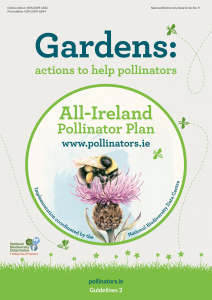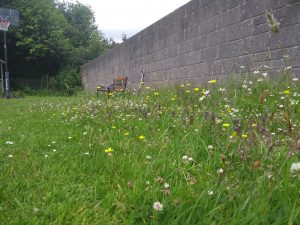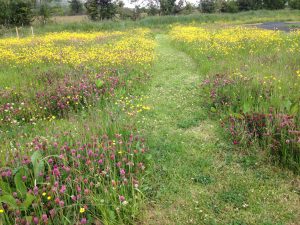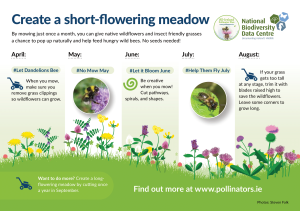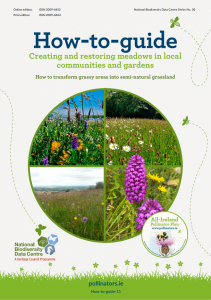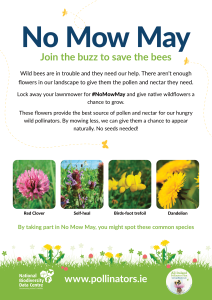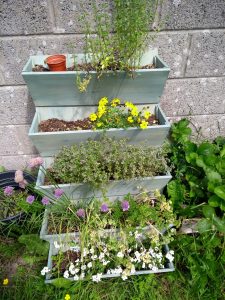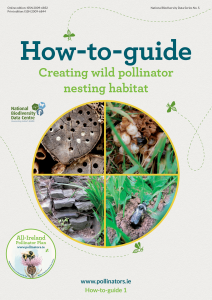Gardens
How can I help pollinators in my garden?
On the island of Ireland, one third of our wild bees (bumblebees and solitary bees) are threatened with extinction. This is mainly because we’ve drastically reduced the habitats that provide them with food and shelter. Other factors include pesticides, pests and diseases, and climate change.
To help these important insects, we need to ensure pollinators have food, shelter, and safety from chemicals.
Creating a landscape where pollinators can survive and thrive
Gardens can play an important role in creating an Ireland where pollinators can survive and thrive. Whether you live in the city or the country, have a big garden or a small back yard, a balcony, or even just a window box, you can help create a network of vital pollinator-friendly pitstops in our landscape. It’s all about how you manage it.
Read on to find out how to help pollinators in your garden (and what not to do!) All of the actions below are supported by evidence and are kept up to date with the latest research from the Irish Pollinator Research Network. For further information, see our free guideline: Gardens: Actions to help pollinators
1. Identify and protect existing areas that are good for pollinators
The most important first step in creating a pollinator-friendly garden is to protect what’s already there. You might be surprised by what’s providing food or shelter in your outdoor space without you realising!
Look for native, naturally growing wildflowers. Are Dandelions popping up in the lawn, or through cracks in the patio? Do you have native flowering hedgerow like Hawthorn, Ivy, Holly or Bramble? Are there patches of bare earth, drystone walls, or little wild areas?
It’s easy to overlook these mini habitats, but they’re probably already providing a lifeline for pollinators and other insects. Make it your first task to protect them. You could even draw a map of your garden, highlighting the pollinator-friendly areas to remind yourself of where they are.
2. Mow less in grassy areas
Many of us are used to keeping our lawns neat and tidy. But to a hungry bee, a closely cropped lawn looks like a barren desert with no wildflowers to provide nectar and pollen.
The colourful blooms in ‘wildflower’ seed mixes are not the same as the native, naturally occurring wildflowers that our pollinators really need – species like Clovers, Dandelions, and Birds-foot Trefoil. You don’t need seed mixes to make these flowers appear – you just need to mow less. It’s far cheaper, and better for biodiversity!
Native wildflowers need nutrient-poor soil to grow. Most of our regularly-mown lawns are too fertile for them to survive. By mowing less, and removing grass clippings when you do mow, you will gradually reduce the soil fertility over time, and wildflowers will appear on their own.
There are a few options for reducing mowing, depending on your space. You don’t have to let your whole lawn grow wild – even mowing a section or strip of grass a little less than usual can make a difference:
Short-flowering meadow: Cut once a month rather than every couple of weeks. Dandelions will flower in April, and Clovers in May and June. Other plants like Bird’s-foot-trefoil and Self-heal will naturally pop up later in the summer if given a chance.
Long-flowering meadow: In some areas, considering cutting just once a year in September after the seeds have dropped. You must remove the grass cut. This allows wildflowers to bloom throughout the summer such as Ox-eye daisy, Field scabious and Knapweed. It can take a couple of years for long-flowering meadows to fully establish, but after a few years of managing your meadow in this way you will be rewarded with a true, native, flower-rich meadow.
Leave some areas entirely undisturbed: Leaving some areas of undisturbed long grass provides safe nesting sites for insects over winter.
Find out more:
|
How-to guide: Creating and restoring meadows in local communities and gardens |
|
3. Pollinator-friendly planting
Pollinators need flowers that produce lots of nectar (for energy) and pollen (for protein). Some plants are better food sources than others. Native plants are always best for our pollinators, but in some cases non-native ‘ornamental’ plants can be used to supplement the food supply. Make sure you keep them to your garden, and don’t spread them in the wider landscape.
Pollinator-friendly planting is a great action if you don’t have much space. Even a pot or a window box can be filled with rosemary, lavender, or heathers. The key is to avoid ‘hunger gaps,’ or times when there are no nectar or pollen-rich flowers in bloom.
Perennials are generally better than annuals, and single-flowered are better than double-flowered varieties. Popular plants like Daffodils, Geraniums, Begonias, Busy Lizzy, and Petunias have virtually no pollen and nectar and are of little value to pollinators.
There are a huge variety of garden plants to choose from that are colourful, attractive, and can provide pollinators with the food they need: Top Ten Pollinator-friendly Plants for Different Situations
Trees and hedgerows
Planting native tree and hedgerow species is a great action for pollinators. They often flower early in the year when other food sources are scarce. Choose species like Hawthorn, Blackthorn, Rowan, Willow, or Crab apple. Make sure you choose local provenance native trees to prevent the spread of diseases.
Non-native fruit trees can also be a good choice for pollinators, providing food for pollinators with spring blossom, and fruit later in the year for birds, mammals, and you!
Find out more
Top Ten Pollinator-friendly Plants for Different Situations
Pollinator-friendly Garden plants
How-to guide: Traditional orchards and fruit trees
Planting trees for pollinators
4. Provide wild pollinator nesting habitat
Most bees don’t live in hives. Wild pollinators nest in hedgerows, wild areas, dry stone walls, and even in the ground. To make a nesting habitat for them, just scrape back some bare earth, leave some areas to grow wild, or simply drill holes 10cm deep in unvarnished wood for solitary bees. Bee hotels provide nesting habitats for cavity-nesting solitary bees. Make sure these are no bigger than an average-sized bird box to prevent spreading diseases, and attracting predators.
Choose areas that are close to flowers. Bumblebees need food within about one kilometre of their nests, and solitary bees will only travel a few hundred meters. You could also protect an old stone wall, a south facing earth bank, a hedgerow, or reduce mowing.
Think twice about getting honey bees
We don’t recommend getting a honey bee hive to help biodiversity. On the island of Ireland, we have one honey bee species, and it is not in decline. If we have too many honey bee hives in the landscape, they can compete for food with our struggling wild pollinators (bumblebees and solitary bees).
If you are thinking of getting a hive of honeybees to start a new hobby, please get in touch with your local beekeeping association to learn how to keep healthy honeybees; avoid spreading disease to other hives and to our struggling wild pollinators.
Find out more:
Creating wild pollinator nesting habitat
Article: Too many honey bees can threaten wild bees
5. Eliminate pesticide use
Pesticides (herbicides, insecticides and fungicides) are potent chemical cocktails that have been found to kill, harm, and disorientate pollinators either through direct exposure or by poisoning their food. One of the best things you can do for pollinators is avoid using them. If you buy plants at a garden centre, ask if they have been treated with chemicals. Even ‘bee friendly’ labelled plants may have been treated with pesticides.
Note: Herbicides may still be needed to remove invasive species such as Japanese Knotweed.
6. Pledge your Garden for Pollinators
‘Pledging your garden for pollinators’ means you have chosen to make it a healthy pitstop for pollinators in the landscape.
Add your garden to our online map ‘Actions for Pollinators’, join a network of pollinator-friendly spaces, and help us track our progress to create an Ireland where pollinators can survive and thrive.
Create an account here: Actions for Pollinators account registration
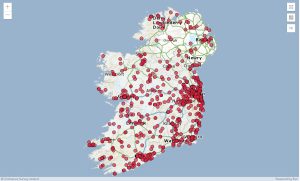
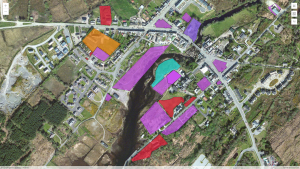
Further resources:
Gardens: Actions to help Pollinators

